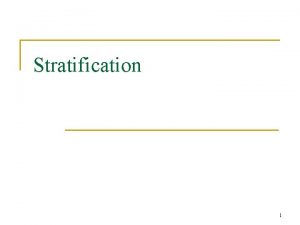Neural correlates of modified state of consciousness induced

- Slides: 1

Neural correlates of modified state of consciousness induced by hypnosis using EEG-connectivity approach Panda R¹, Gosseries O¹, Vanhaudenhuyse A², Demertzi A¹, Piarulli A¹, Faymonville ME² & Laureys S¹ ¹ GIGA-Consciousness, Coma Science Group & Neurology Department, University & University Hospital of Liège, Belgium ² Algology and Palliative Care Department, University Hospital of Liege & Sensation and Perception Reseach Group, GIGA consciousness, Liège, Belgium Introduction Method • Hypnosis is an altered subjective states of consciousness during which the internal and external awareness change. • Hypnotic state has been shown to be of clinical utility, however its neural mechanisms still remain unclear ¹. • Functional MRI studies have shown altered default mode network and executive network connectivity with varying brain connectivity patterns. Hence, neuroelectrophysiology (EEG) may provide more information¹. • This study investigates the neural basis of hypnosis using resting state EEG connectivity measurements. • Ten healthy subjects (7 females, age 24± 3 years). • EEG recorded in neutral hypnosis state and during normal wakefulness. • The hypnotic state instruction involved a 3 -min induction procedure with muscle relaxation and eye fixation. • Five minutes EEG data analysed using both hypothesis and data driven connectivity approach. • Frequency decomposition for delta, theta, alpha, beta 1 and beta 2 frequency bands. • Connectivity between every pair of electrodes was assessed using weighted Phase Lag Index (w. PLI)². • Hypothesis-based connectivity was computed for frontal, parietal and midline regions. • Data-driven graph theory connectivity was carried out to measure brain connectivity network properties and altered hub regions². Results Hypnosis Baseline Hypnosis > Baseline Delta Theta Alpha Beta-2 Decrease connectivity Figure 1. Spectral power showed: • Increased delta • Decrease beta-2 and alpha Increase connectivity Figure 2. Frontal, parietal and midline regions connectivity for hypnosis compare to baseline: • Increased frontal interhemispheric connectivity in delta, and left frontal to right parietal in theta band. • Decreased connectivity for alpha and beta bands in upper central with lower central, right frontal with ‘right parietal and upper central’ regions. Conclusion • During hypnosis, we found increased connectivity in the lower frequency range (i. e. , delta) and decreases in higher frequencies (i. e. , beta) when considering frontal and parietal regions. • These oscillations (increased low frequency & decrease high frequency) seems to characterize modified subjective state of consciousness induced by hypnosis, possibly reflecting states of efficient cognitive-processing and positive-emotional experiences. References: ¹Landry, M, et al. Brain correlates of hypnosis: A systematic review and metaanalytic exploration. Neuroscience & Biobehavioral Reviews. (2017). ²Hardmeier, M. , et al. Reproducibility of functional connectivity and graph measures based on the phase lag index (PLI) and weighted phase lag index (w. PLI) derived from high resolution EEG. PLo. S One. (2014). Decrease Increase Figure 3. The graph theory analysis of integrated nodal clustering coefficient measures showed: • Increased delta and theta connectivity in frontal (F 4, Fz, FCz) and parietal (P 3) areas. • Decrease beta-2 and alpha in frontal (F 3, F 4, AF 1) and parietal (Poz, PO 4) regions. Contact : rajanikant. panda@uliege. be

